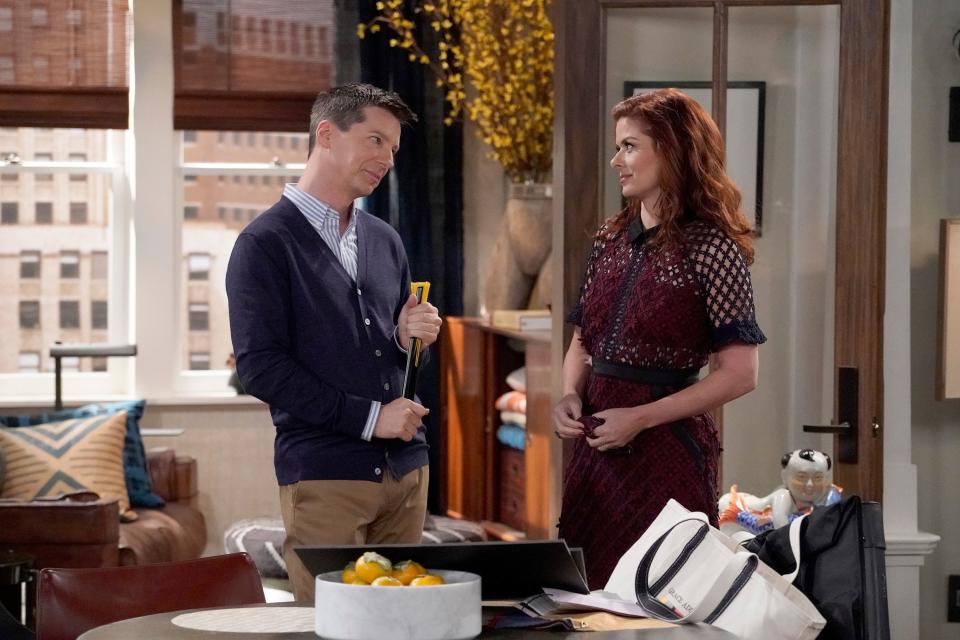Americans see more LGBTQ people on TV these days. That's absolutely crucial for our cause.
LGBTQ Pride Month began after the 1969 Stonewall riots, a protest of LGBTQ liberation led by transgender women of color. But Pride Month is everywhere now: Brand logos add rainbow hues, hundreds of Pride marches take place in large cities and small towns, and social media lights up with messages of love and acceptance.
LGBTQ visibility is reaching new heights outside of Pride Month, too. Nearly 12% of TV series regular characters on scripted primetime broadcast shows today are LGBTQ. When GLAAD first started our "Where We Are on TV" report 26 years ago, we counted only 12 LGBTQ series regular characters. Our latest report counted 637 LGBTQ characters.
Beyond the entertainment industry, last year at least 184 out LGBTQ candidates won elected office. There are out LGBTQ people in Fortune 500 C-suites, serving as primetime news anchors, leading religious congregations, playing professional sports – the list goes on.
Visibility is a double-edged sword and has been met with an onslaught of harmful anti-LGBTQ bills and other forms of violence across the country. Our community is under assault, and the attacks fall especially on young people, transgender people, people of color and those living in the U.S. South.
As a lesbian mother, I’m appalled at the lack of compassion some Republican policymakers are showing to trans young people and their parents right now. In Texas, Gov. Greg Abbott issued a directive calling for child abuse investigations of parents who allow gender-affirming medical procedures for their trans children. More than two dozen bills have been introduced in other states to restrict evidence-based, lifesaving gender-affirming health care for trans youth.
Alabama even enacted a law that would turn doctors providing this care – care supported by major medical associations – into felons.
'Praying for myself too': Parents struggle with goodbye after another school shooting
The assault continues: Other states, including Ohio and Georgia, are introducing bills that mimic Florida's "Don’t Say Gay" bill. Though Gov. Ron DeSantis claims the intention is to block age-inappropriate teachings about sex, Florida lawmakers cannot show evidence those teachings even exist, and the bill could actually end any discussions that note the existence of LGBTQ people.
Meanwhile, children’s books with LGBTQ characters are being banned left and right, leaving kids like mine – with two moms – unable to discuss their families in the classroom or see themselves in books.
In a recent survey, the Centers for Disease Control and Prevention found that 1 in 4 LGBTQ youth attempted suicide in the first half of 2021. And 94% of LGBTQ youth reported that recent political discussions negatively impacted their mental health, according to The Trevor Project.
Public representation builds familiarity
When anti-LGBTQ proposals are discussed and passed in state houses, they inevitably become the topics discussed on the news. That makes the power of Hollywood even more important. While our community is fighting tough, ugly political battles captured on the local 6 o'clock news, I want Americans to be able to flip the channel and see another story: a story that humanizes LGBTQ people, including trans people.
When people get to see the entirety of our community in high-quality, nuanced news stories and get to know us through Hollywood productions, it builds familiarity, which is the bridge to acceptance.
Depp-Heard and the public: Amber Heard lost in the court of public opinion. Johnny Depp's fans made sure of that.
But even with a huge uptick in representation, many stories are still not being told. Often, because of fault lines of power and privilege, those among us who are missing from TV screens are the same members of our community who are most vulnerable to harm.
Black LGBTQ people in the South are experiencing an HIV crisis. More than half of the 36,800 new HIV diagnoses in the United States and its territories in 2019 were in the South, with Black people representing the greatest share. You likely wouldn’t know any of this from watching TV, movies or even the news.
Just two TV characters living with HIV were counted in GLAAD's 2021-22 "Where We Are on TV" report. In our analysis of local news media coverage, we counted 1,300 stories over 18 months about or including LGBTQ people across all nine Southern states, and only 79 stories addressing HIV, in a region where nearly 500,000 people are living with HIV. Telling stories about HIV and people living with HIV leading long, healthy lives – especially stories specific to the Southern Black context – is critically important to eliminating the stigma that blocks prevention and treatment.
He was principal at Columbine: He gets asked over and over why little has changed.
Representation of transgender people on TV similarly leaves much room for improvement. Although GLAAD counted an increase in the number of transgender characters on TV last year, the percentage of transgender characters of total LGBTQ characters actually decreased.
Twenty-five years ago, equal protections for gay and lesbian people – and the idea of marriage equality – were unfamiliar and unpopular. But thanks to hard work at state houses across the country and Obergefell v. Hodges, marriage equality is the law of the land.
What happened in the time in between, alongside that on-the-ground legislative work? Americans watched TV. They got to know gay people through sitcoms, dramas and more nuanced news stories about our community.

Ellen DeGeneres came out 25 years ago, and her character on "Ellen" did too. "Will & Grace" premiered the following year, bringing out gay characters to America's living rooms for eight years.
By 2015, when the Supreme Court ruled in favor of marriage equality, there were 119 lesbian, gay or bisexual regular characters on broadcast and cable television (and zero trans characters that year).
As I think about the heartbreak LGBTQ youth, and especially trans youth, are going through right now, I know we need more and more visibility for trans people on television, in movies and in the news. With visibility comes understanding. Nuanced, inclusive stories that humanize LGBTQ people and issues can be leading forces in defeating this dangerous wave of anti-LGBTQ bills.
More progress to be made
The Equality Act, critical federal legislation that would protect LGBTQ people from discrimination, remains stalled in the U.S. Senate, though it passed the U.S. House in a bipartisan vote at a time when three-quarters of Americans support LGBT nondiscrimination laws.
There’s so much work to be done politically, but also in Hollywood, in local communities, in business, everywhere. The corporations that tell our stories through news, advertising, TV series and films – or by slapping a rainbow onto their logo during Pride – need to go further.
There are far too many companies that want to walk in our parades, but still donate to the politicians who are trying to strip us of our hard-won progress. Too many corporations want to brand themselves as LGBTQ-friendly but have nothing to say when elected leaders target our right to health care, our books, our children.
LGBTQ leaders fight for representation because we know what people see in the media has a huge impact on the decisions made in offices, classrooms, living rooms, courtrooms and the ballot box. The American people will not support legislative attacks against people they know.
But what we’re really fighting for, ultimately, is the safety and freedom to live as ourselves and have the same opportunities as every other American. The progress we’ve won so far is not safe until we’re all there.

Sarah Kate Ellis is president and CEO of GLAAD, the world's largest LGBTQ+ media advocacy organization. Prior to GLAAD, Ellis was a media executive who ran marketing for magazines. Ellis has also co-authored books with her wife, Kristen Ellis-Henderson, including "All Moms" and "Times Two, Two Women in Love and the Happy Family They Made." Follow her on Twitter: @sarahkateellis
You can read diverse opinions from our Board of Contributors and other writers on the Opinion front page, on Twitter @usatodayopinion and in our daily Opinion newsletter. To respond to a column, submit a comment to letters@usatoday.com.
This article originally appeared on USA TODAY: LGBTQ rights: Rainbow flags aren't enough to advance our cause

